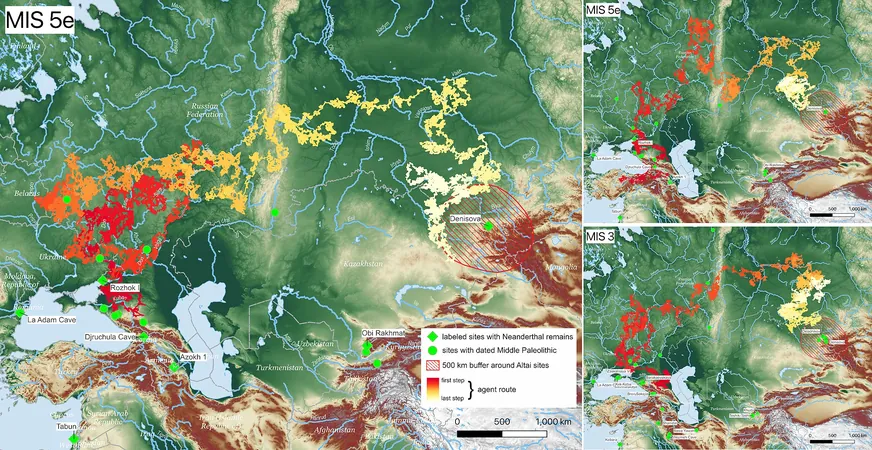
Unlocking Neanderthal Journeys: How Supercomputers Recreated Ancient Migration Highways!
2025-06-11
Author: Siti
A Groundbreaking Revelation About Neanderthal Migration
Recent computer modeling unveils astounding insights into Neanderthal migration across northern Eurasia, revealing they traversed a vast stretch of about 2,020 miles (3,250 km) in under 2,000 years! This epic journey utilized natural river valleys as efficient highways for their travels.
Faster and More Predictable Than Ever Imagined
Led by researchers Emily Coco and Radu Iovita from New York University's Center for the Study of Human Origins and Portugal's University of Algarve, this research challenges previous notions about the speed and reliability of Neanderthal migrations. Their findings provide crucial context to earlier genetic indications of late-Pleistocene movement.
How Did They Do It? Simulating an Epic Voyage!
The researchers used a 1 km-resolution map of Late Pleistocene Eurasia, complete with detailed features like rivers, glaciers, and deserts, to create an agent-based least-cost path (AB-LCP) model. This sophisticated simulation mirrored how individuals navigate landscapes by minimizing travel costs without the luxury of complete geographical knowledge.
Impressive Findings from Simulation Runs
Each virtual traveler in the simulation made 400,000 decisions, moving through the environment with an average of 830,000 steps! Depending on their journey, Neanderthals could reach Siberia's Altai region in as few as 925,000 to 1.1 million steps—translating into about 620,000 miles (one million kilometers) of wandering at hunter-gatherer speeds.
Rivers as Ancient Highways
The virtual paths closely followed the expansive Volga-Kama corridor and funneled eastward along river valleys. These waterways not only guided them but also minimized the challenges posed by mountainous terrains. "Our research reveals that despite natural obstacles, Neanderthals could cross northern Eurasia much more swiftly than we thought," Coco stated.
Climate: The Hidden Ally in Their Migration
The study identified two warm climatic windows—Marine Isotope Stage 5e and Marine Isotope Stage 3—where Neanderthal migrations thrived. Warmer temperatures reduced glacial coverage and provided lush vegetation, paving the way for safe crossings along river routes.
Linking Neanderthals and Denisovans!
Interestingly, the preferred northern route intersects with areas believed to have been inhabited by Denisovans during those warm periods, evidence supporting genetic links and interactions between these two ancient groups.
Misconceptions About Migration Routes
The simulations debunked theories of a viable southern route around the Caspian Sea, suggesting that research efforts should focus on the riverine corridors north of the desert regions.
The Future of Migration Studies
This groundbreaking research showcases the power of computer simulations in shedding light on ancient human migrations. Neanderthals may not have needed advanced navigation skills; they simply followed the guidance of their natural environment, transforming their journey across a continent from a dramatic timeline into a believable historical trek.




 Brasil (PT)
Brasil (PT)
 Canada (EN)
Canada (EN)
 Chile (ES)
Chile (ES)
 Česko (CS)
Česko (CS)
 대한민국 (KO)
대한민국 (KO)
 España (ES)
España (ES)
 France (FR)
France (FR)
 Hong Kong (EN)
Hong Kong (EN)
 Italia (IT)
Italia (IT)
 日本 (JA)
日本 (JA)
 Magyarország (HU)
Magyarország (HU)
 Norge (NO)
Norge (NO)
 Polska (PL)
Polska (PL)
 Schweiz (DE)
Schweiz (DE)
 Singapore (EN)
Singapore (EN)
 Sverige (SV)
Sverige (SV)
 Suomi (FI)
Suomi (FI)
 Türkiye (TR)
Türkiye (TR)
 الإمارات العربية المتحدة (AR)
الإمارات العربية المتحدة (AR)